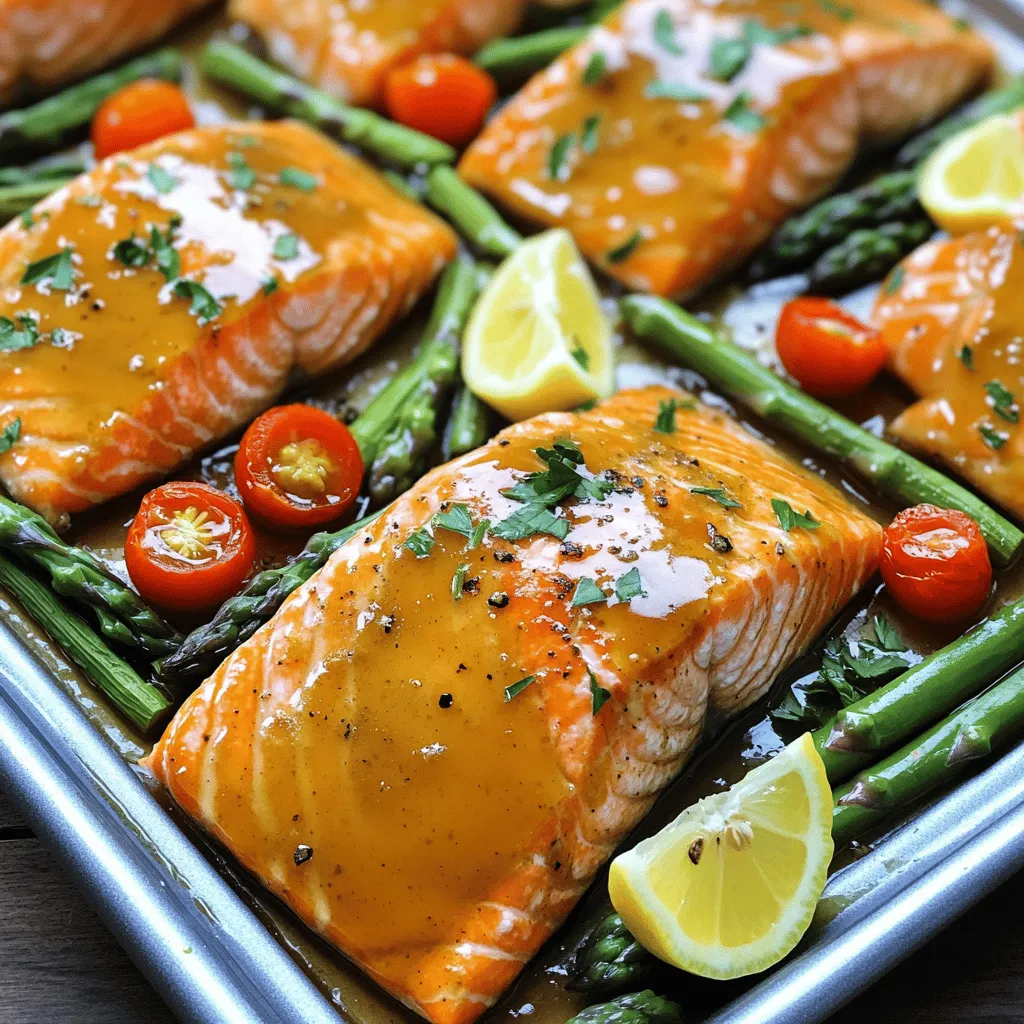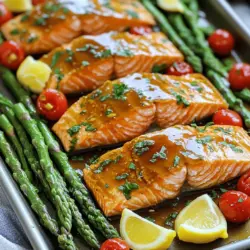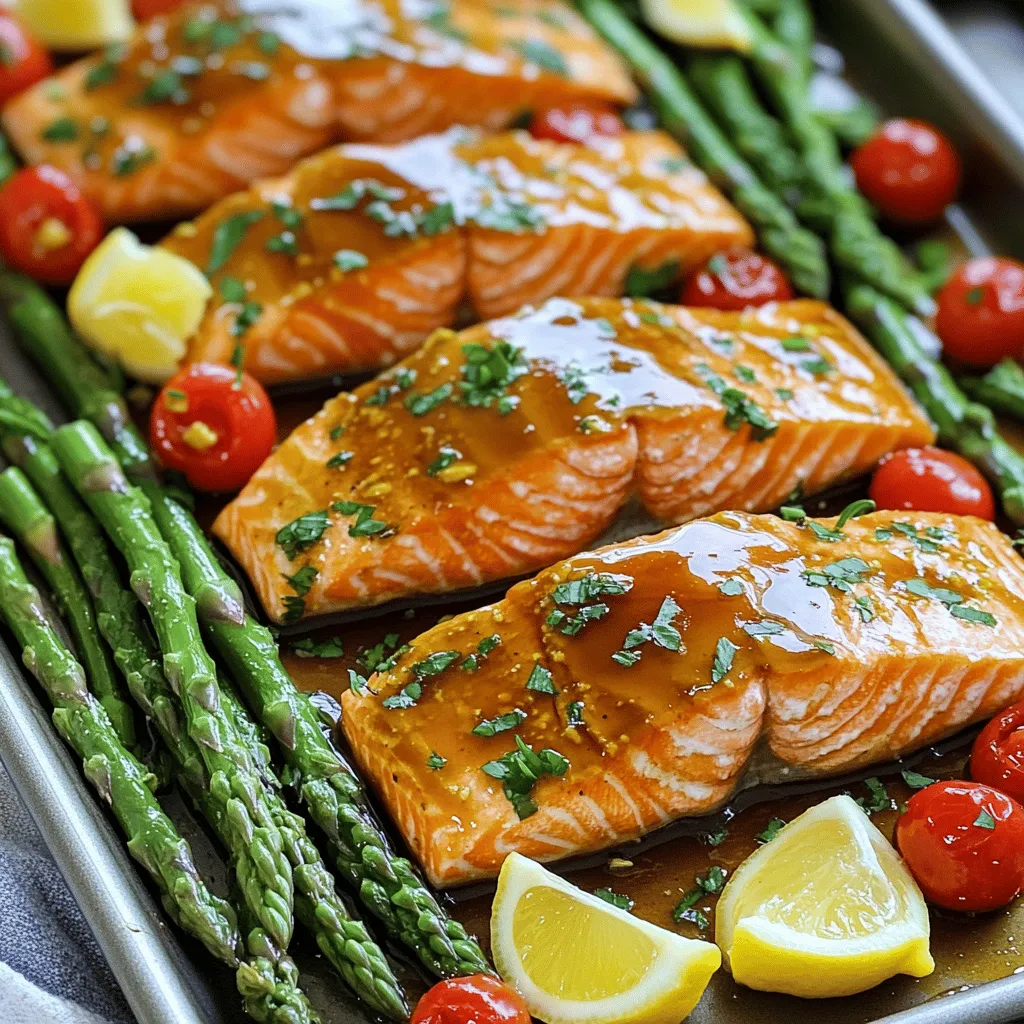Looking for a quick and tasty meal? Try my Sheet Pan Maple Dijon Salmon. This dish is not just healthy; it’s super easy to make. With just a few fresh ingredients like salmon, maple syrup, and Dijon mustard, you’ll create a mouthwatering dinner in no time. Plus, the added veggies make it a complete meal. Let’s dive into how to whip up this delicious recipe that the whole family will love!
Ingredients
Main Ingredients
- 4 salmon fillets (about 6 oz each)
- 1/4 cup pure maple syrup
- 3 tablespoons Dijon mustard
Additional Ingredients
- 2 tablespoons soy sauce (or tamari for gluten-free)
- 1 tablespoon olive oil
- 2 cloves garlic, minced
- 1 teaspoon fresh ginger, grated
Vegetables
- 1 pound asparagus, trimmed
- 1 cup cherry tomatoes, halved
- Lemon wedges, for serving
- Fresh parsley, chopped, for garnish
The main ingredients include fresh salmon fillets, rich maple syrup, and zesty Dijon mustard. These flavors create a sweet and savory taste that makes the dish pop. The additional ingredients, soy sauce, olive oil, garlic, and ginger, add depth and brightness to the meal.
You can’t forget the veggies! Asparagus and cherry tomatoes roast beautifully next to the salmon. They soak up the flavors and add color to your plate. Finally, lemon wedges and parsley give the dish a fresh look and taste.
Step-by-Step Instructions
Preparation
1. Preheat your oven to 400°F (200°C). This step helps your meal cook evenly and quickly.
2. Line a large baking sheet with parchment paper. This makes cleanup easy and keeps your salmon from sticking.
Making the Marinade
1. In a small bowl, mix the maple syrup, Dijon mustard, soy sauce, olive oil, minced garlic, and grated ginger. Combine these well for a tasty marinade.
2. Marinating is vital. It adds flavor and helps keep the salmon moist while cooking.
Assembling the Dish
1. Place the salmon fillets on one side of the baking sheet. This keeps them separate from the veggies.
2. Brush the tops of the salmon with the marinade. Save some marinade for later to add more flavor.
Cooking
1. Bake everything in the oven for about 15-20 minutes. The salmon should flake easily when done.
2. Check for doneness by gently pressing the salmon with a fork. If it flakes easily, it’s ready to eat.
Tips & Tricks
Perfecting the Salmon
To achieve flaky salmon, you need to cook it just right. Look for salmon that flakes easily with a fork. This means it’s done. Overcooking can lead to dry fish. A good tip is to use a meat thermometer. Aim for an internal temperature of 145°F (63°C).
Marinating the salmon is key to flavor. Allow it to sit for at least 15 minutes. This gives the fish time to absorb the tasty maple Dijon mix. If you can, marinate for up to an hour for an even richer taste.
Vegetable Cooking Tips
Seasoning your vegetables can make a big difference. A simple mix of olive oil, salt, and pepper works great. You can also add garlic powder or dried herbs for more flavor.
Adjust cooking times based on your taste. If you like your asparagus crisp, check it at 15 minutes. For softer veggies, let them cook a few extra minutes. Just remember to keep an eye on the salmon too!
Serving Suggestions
Pairing side dishes can elevate your meal. Try serving with rice or quinoa for a complete dinner. A fresh salad also goes well, adding crunch and color.
For garnishes, lemon wedges add brightness. Fresh parsley brings a nice touch. Arrange the salmon and veggies neatly on the plate. It makes for a beautiful presentation.

Variations
Ingredient Swaps
Alternative fish options
You can swap salmon for other fish. Good choices are tilapia, trout, or cod. These fish have mild flavors and cook quickly. They will soak up the maple Dijon sauce well.
Substituting vegetables
Feel free to change the veggies. Broccoli, zucchini, or bell peppers work well. Each adds its own texture and taste. Just make sure to cut them into similar sizes for even cooking.
Flavor Enhancements
Adding spices or herbs
Want to boost the flavor? Add spices like paprika, cayenne, or cumin. Fresh herbs like dill or thyme can also add a nice touch. Just sprinkle them on before cooking.
Suggested glaze variations
You can mix up the glaze too. Try adding orange juice or balsamic vinegar. These changes will give your dish a unique twist. You can even use honey instead of maple syrup for a different sweetness.
Different Cooking Methods
Grilling vs. baking
You can grill the salmon for a smoky taste. Just make sure to oil the grill to prevent sticking. Baking is easier and perfect for busy nights. Both methods keep the fish moist.
Sheet pan vs. individual servings
This recipe is great for a sheet pan meal. But you can also cook individual portions. Just use smaller pans and adjust the cooking time. Either way, you get a tasty meal.
Storage Info
Refrigeration
To store leftovers, place the salmon and veggies in an airtight container. This keeps them fresh. You can refrigerate the meal for up to three days. Make sure it cools down to room temperature before sealing it. This helps prevent moisture build-up, which can make your food spoil faster.
Reheating Instructions
To safely reheat salmon, use a gentle method. The oven is best. Preheat it to 275°F (135°C). Place the salmon on a baking sheet. Cover it with foil to keep it moist. Heat for about 15 minutes or until warm.
You can also use the microwave. Just place the salmon on a microwave-safe plate. Heat in short bursts of 30 seconds. Check often to avoid overcooking. The salmon can dry out if heated too long.
Freezing Guidelines
You can freeze cooked salmon and vegetables. Place them in a freezer-safe container. Use parchment paper between layers to avoid sticking. This keeps them fresh for up to three months.
To thaw properly, move the salmon to the fridge overnight. This keeps the texture nice. You can also use the microwave’s defrost setting, but this may change the texture a bit. Always check that the salmon is fully thawed before reheating.
FAQs
How do I know when the salmon is done?
You can check if the salmon is done by looking for a few signs. First, the salmon should be opaque and not translucent. When you poke it with a fork, it should flake easily. The best way is to use a food thermometer. The internal temperature should reach 145°F (63°C). This ensures it is safe to eat and still juicy.
Can I use a different type of syrup?
Yes, you can try other syrups. While maple syrup adds a unique flavor, honey and agave syrup are great alternatives. Honey gives a sweeter taste, and agave is milder. Just keep in mind that these options may change the final flavor of your dish.
What can I serve with Sheet Pan Maple Dijon Salmon?
This dish pairs well with many sides. Some great options include:
- Quinoa or rice for a hearty base
- Roasted sweet potatoes for sweetness
- A fresh green salad for crunch
- Garlic bread for a tasty addition
Feel free to mix and match to create a balanced meal.
This blog post walked you through making a tasty Sheet Pan Maple Dijon Salmon. You learned about the simple ingredients, how to prepare the dish, and tips to cook it perfectly. Remember to marinate your salmon well and season your veggies to boost flavor. You can even switch ingredients for a unique twist. Now, you can enjoy a delicious meal that is easy to make and good for you. Get ready to impress your friends and family with this dish!

